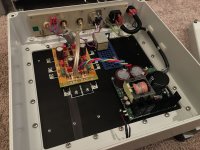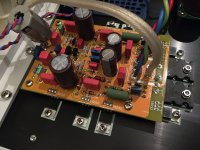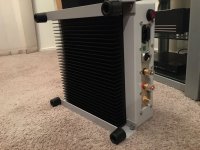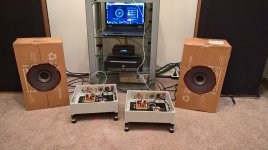Could you take a photo of the SMD soldered to your board, please?
the end was sold, but with the 5551 and 5401, as per the wishes of the customer who also wanted the 108 filter with its can caps, let us understand something.
for convenience they were welded under the printout and overturned with pieces of terminals of 4148
allow me a comment.
The 108 or that circuit type always retains the same characteristic or DNA, that is, a very particular sound, being the open loop scheme.
Therefore it requires great attention, choice and selection of assets, but also of passives.
An input with PNP and NPN can already be a problem (I am a supporter of the DC tout) both with the selection and for the control of the offset; so here is the entry cap that affects so much and the supercap.
In DNA it remains, that is, medium and high very attractive based on the input cap and supercap, but always attractive regardless of the nature of the circuit.
However low, medium-low, dynamics in general and speed are not the strong point of this scheme, on the contrary.
It depends on what you want and look for, if you want transparency, speed, bass, dynamics etc. the 108 is not the right scheme.
It remains that this scheme can be improved in the parameters in which it does not excel, improved, not distorted.
We even tried to battery power the entrance, good, but is it worth complicating a scheme in this way?
I say that if you look for other parameters there is better, less critical and less demanding, but tastes are not discussed.
We dispel the fable that the scheme of the 108 winks at the 300B, it is not true at all and we consider that the 108 was developed based on a large band speaker.
The 108 or that circuit type always retains the same characteristic or DNA, that is, a very particular sound, being the open loop scheme.
Therefore it requires great attention, choice and selection of assets, but also of passives.
An input with PNP and NPN can already be a problem (I am a supporter of the DC tout) both with the selection and for the control of the offset; so here is the entry cap that affects so much and the supercap.
In DNA it remains, that is, medium and high very attractive based on the input cap and supercap, but always attractive regardless of the nature of the circuit.
However low, medium-low, dynamics in general and speed are not the strong point of this scheme, on the contrary.
It depends on what you want and look for, if you want transparency, speed, bass, dynamics etc. the 108 is not the right scheme.
It remains that this scheme can be improved in the parameters in which it does not excel, improved, not distorted.
We even tried to battery power the entrance, good, but is it worth complicating a scheme in this way?
I say that if you look for other parameters there is better, less critical and less demanding, but tastes are not discussed.
We dispel the fable that the scheme of the 108 winks at the 300B, it is not true at all and we consider that the 108 was developed based on a large band speaker.
Last edited:
You've hit the nail on the head.......
However low, medium-low, dynamics in general and speed are not the strong point of this scheme, on the contrary.
It depends on what you want and look for, if you want transparency, speed, bass, dynamics etc. the 108 is not the right scheme.
...
Yesterday I have completed my Krell KSA-50 project and was able to compare NHB-108 with KSA-50 side-by-side. Krell has powerfull, almost exaggerated bass and in general it sounds rather energetic. A stalion.
On the other hand NHB-108 has a delicate sound over the entire range and keeps bass on the right, modest level. It makes magic in compartment of delicate classical works: solo vocals are crystal clear, delicate passages sound like performed on the stage. On the other hand, in modern music Krell excells, an amplifier on steroids.
Last edited:
perfect, although Krell may seem overwhelming at times. (I don't appreciate it too much, but it has its own characteristic)
The old 50 was not bad, on the contrary.
It always depends on what you are looking for.
I find the 108 limited, but only because I compare it with our final which has all other characteristics and is thought in a different direction.
I would say that the 108 has a beautiful interpretation charm pimp
The old 50 was not bad, on the contrary.
It always depends on what you are looking for.
I find the 108 limited, but only because I compare it with our final which has all other characteristics and is thought in a different direction.
I would say that the 108 has a beautiful interpretation charm pimp
completed 108 clones
Completed my clones a while ago.
Using connexelectronic smps without any problems. Used high tolerance, low temp coefficient resistors throughout and gain matched relevant transistors.
Offset stable around 10mV (25mV after 1 hr) on both units. big heatsinks needed.
Completed my clones a while ago.
Using connexelectronic smps without any problems. Used high tolerance, low temp coefficient resistors throughout and gain matched relevant transistors.
Offset stable around 10mV (25mV after 1 hr) on both units. big heatsinks needed.
Attachments
Mr I
Since mje15032 and mje15033 can not be matched, do you mean the relevant transistors are the 2n5401 and 2n5551?
Thx
Yes
if I can allow myself:
don't waste money on so many expensive filter caps.
with this 1 or 2 pair circuit, two top quality caps per channel and a 300 VA transformer are enough
I had a 1500 W 2 x 36 vac Toroidy laying so I used it. Use 6x 68000 Uf. Why do you recommend small transformer and only two capacitors? I think more result in better sound.
Completed my clones a while ago.
Using connexelectronic smps without any problems. Used high tolerance, low temp coefficient resistors throughout and gain matched relevant transistors.
Offset stable around 10mV (25mV after 1 hr) on both units. big heatsinks needed.
is swirching your job or did you buy it?
Put so close to the entrance does not cause problems?
Can you write any data on that power supply?
Completed my clones a while ago.
Using connexelectronic smps without any problems. Used high tolerance, low temp coefficient resistors throughout and gain matched relevant transistors.
Offset stable around 10mV (25mV after 1 hr) on both units. big heatsinks needed.
I do not not understand the need for big heatsink. Mine takes several hours to rise a little in temperatur.
I had a 1500 W 2 x 36 vac Toroidy laying so I used it. Use 6x 68000 Uf. Why do you recommend small transformer and only two capacitors? I think more result in better sound.
I used 300VA and 2 x 22000 micro 100 volt transformers for testing.
It is a limitation to use 63 volt filter caps when supplying 55 vdc, better to use 100 volts.
I write that I suggest not to spend too much on many filter caps which in total would be 12 of 22,000 and 63 volts because I didn't feel any difference in using 4, 2 per channel, instead of 12, 6 per channel.
A similar storage tank makes little sense for a similar scheme, better to use less caps, but always of quality.
I'd be almost sure that all those expensive caps and those 1000 VA transformers each are a filler of the box to justify the crazy price of that ending.
It is clear that if one has them at home he can use them, but it really changes to zero, in my opinion. All that stuff for a couple per channel is unreasonable
is swirching your job or did you buy it?
Put so close to the entrance does not cause problems?
Can you write any data on that power supply?
Bought them for another project initially.
SMPS500R | Connex Electronic
I do not not understand the need for big heatsink. Mine takes several hours to rise a little in temperatur.
I don't know the size of your heatsink, but they might not be biased correctly.
darTZeel NHB-108 Model One power amplifier Measurements | Stereophile.com
ailments?
and how do they work?
Are the output voltages stabilized?
have you tried to stress it?
Last edited:
ailments?
and how do they work?
Are the output voltages stabilized?
have you tried to stress it?
They work well.
Very stable output.
I was using them in a pass aleph 5 (single ended class a) for a year.
Connexelectronic has been around for a while.
the conventional, ie floating, filter cell is based on the quality of the capacitors: the electrolytic quality capacitors find them expensive, occupy space and must be wired WELL.
We have modified the 108 modified even in the final stages of power and, if you want to believe me, it is a good step forward compared to floating filtering; in addition, it costs much less, is much better and takes up less space, but it has a cost and requires a certain degree of design.
SE switching provides stabilized voltages is a must, always if it does not radiate or impose other problems; but in this regard it is possible, if it radiates, to resort to the Faraday cage (which I would do anyway).
The fear of audiophiles for switching power supplies is like the fear of children for the dark: they are VOLTAGES
We have modified the 108 modified even in the final stages of power and, if you want to believe me, it is a good step forward compared to floating filtering; in addition, it costs much less, is much better and takes up less space, but it has a cost and requires a certain degree of design.
SE switching provides stabilized voltages is a must, always if it does not radiate or impose other problems; but in this regard it is possible, if it radiates, to resort to the Faraday cage (which I would do anyway).
The fear of audiophiles for switching power supplies is like the fear of children for the dark: they are VOLTAGES
Voltages they are... but some voltages are created different than others
- Home
- Amplifiers
- Solid State
- Dartzeel amp schematic - build this?



